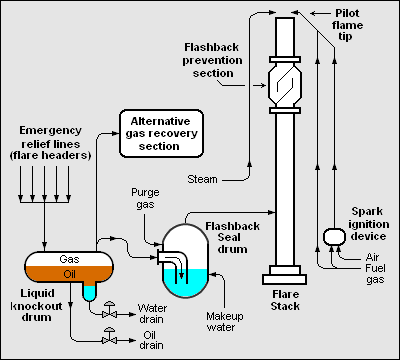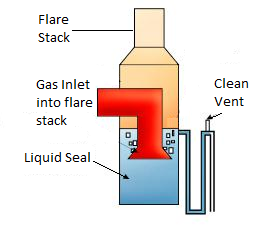Vent and flare systems are common in petroleum plants such as oil & gas refineries, oil and natural gas production and processing facilities etc. The main purpose of having a vent and flare network is to safely dispose off the excess hydrocarbon gases emerging from the plant for various reasons such as - opening of pressure relief valves, planned maintenance shutdown etc.
Flare / vent stack
A flare stack or a vent stack used for safe disposal of the vented gases to the atmosphere. The hydracarbons in a flare stack are continuously burned at the tip. While the vent stack simply disposes them into the air at a sufficient height.
Flare tip
Flare tip is the topmost tip of a flare stack where the purged gases coming from the flare systems are continuously burned. This burning of hydrocarbon gases generates a lot of heat and it is important to design the flare stack high enough to keep the equipment and personnel safe from this heat.
The flare tip and flare stack diameter are designed handling for the maximum possible flow in the flare network. However, the normal gas flow in the flare stack is much lower than the design flow rate, resulting in low exit gas velocities at the flare tip.
Low gas velocities mean that the gas begins to burn much closer to the flare tip than desired, thus causing burn back of the flare tip.
Emissivity coefficient
Emissivity coefficient for a flare tip is the fraction of heat generated at the flare tip that is radiated to surroundings. Not all the heat that is generated by burning hydrocarbon gases at the tip of a flare is radiated. Major fraction of the heat generated by a flare is carried to the surroundings in the form of hot gases by convection and the fraction of this heat is simply radiated to surroundings. This 'emissivity coefficient' is an important parameter for design for flare stack.
Positioning the flare stack with help of radiation plots / isopleths
Radiation plots are representative of the incident radiated heat from flare reaching at different locations in the surroundings. Radiation plots typically consist of isopleths. Isopleths are curves on a map of the flare surroundings which connect geographical points receiving the same intensity of heat radiated from the flare.
These isopleths are important to determine the position, height of flare stack as well as the position of other important equipment in the surroundings.
Purge gas flow and preventing air ingress to flare systems
A flare system in a refinery holds a continuous flow of excess hydrocarbons getting burned in the flare stack. Hence for safety reasons, it is very critical that air ingress should never be allowed in the flare network.
One of the ways to avoid air ingress into the flare stack, vent KO drum, flare network and subsequent catastrophic consequences, is to continuously purge a small flow rate of hydrocarbon gases. This continuous hydrocarbon gas purge flow in the flare network helps to build up some positive backpressure at the vent knock out drum.
Avoiding air ingress with buoyancy and velocity seals
Buoyancy and velocity seals are provide further safeguard to ensure that purge gas flow remains one way - out of the flare network. They minimize possibility of backflow and air ingress into the flare system.
Velocity seal to prevent air ingress
Buoyancy seal typically uses the difference in densities of the purge gas and ambient air to keep the air from entering flare system. Velocity seal is a cone-shaped obstruction placed inside the flare tip so as to obstruct the infiltrating air from ‘hugging the inner wall’. The purge gas flow coming through the cone is a focused stream which sweeps away the infiltrating air along with it.
Liquid seals
A liquid seal at the flare stack base is essentially a cylindrical volume of liquid into which the gas inlet to flare stack is dipped. This volume allows the flow of flared gas from inlet pipe to the stack in form of bubbles rising through the liquid. Liquid seal volume does not permit any air flow entering the gas inlet pipe, thus preventing air ingress into the flare network.


